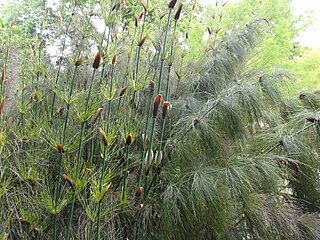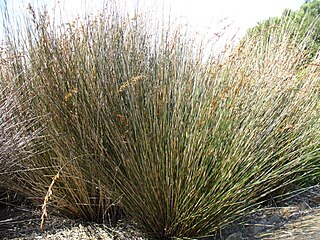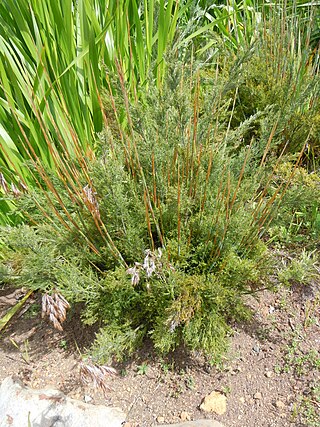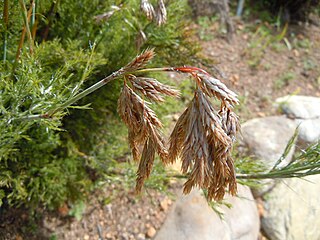
Reed is a common name for several tall, grass-like plants of wetlands.

The Restionaceae, also called restiads and restios, are a family of flowering plants native to the Southern Hemisphere; they vary from a few centimeters to 3 meters in height. Following the APG IV (2016): the family now includes the former families Anarthriaceae, Centrolepidaceae and Lyginiaceae, and as such includes 51 genera with 572 known species. Based on evidence from fossil pollen, the Restionaceae likely originated more than 65 million years ago during the Late Cretaceous period, when the southern continents were still part of Gondwana.

Calandrinia is a large genus of flowering plants known as purslanes and redmaids. It includes over 100 species of annual and perennial herbs which bear colorful flowers in shades of red to purple and white. Plants of this genus are native to Australia, western South America, Central America, and western North America. Some species have been introduced to parts of New Zealand, southern Africa, Asia, and Europe.

Bulbinella is a genus of plants in the family Asphodelaceae, subfamily Asphodeloideae, first described as a genus in 1843. Many species are endemic to Cape Province in western South Africa, confined to the winter rainfall area. Other species are endemic to New Zealand, where they are most common in the central Otago region which enjoys a similar climate to the Cape Region of South Africa.

Eleocharis is a virtually cosmopolitan genus of 250 or more species of flowering plants in the sedge family, Cyperaceae. The name is derived from the Greek words ἕλειος (heleios), meaning "marsh dweller," and χάρις (charis), meaning "grace." Members of the genus are known commonly as spikerushes or spikesedges. The genus has a geographically cosmopolitan distribution, with centers of diversity in the Amazon Rainforest and adjacent eastern slopes of the South American Andes, northern Australia, eastern North America, California, Southern Africa, and subtropical Asia. The vast majority of Eleocharis species grow in aquatic or mesic habitats from sea level to higher than 5,000 meters in elevation.

Lysipomia is a genus of flowering plants in the family Campanulaceae. They are cushion-like mountain plants all endemic to the high Andes. The genus is monophyletic.
Malouetia is a genus of plants in the family Apocynaceae, first described as a genus in 1844. It is native to Africa, South America, Central America, and the West Indies.

Restio is a genus of flowering plants within the family Restionaceae, described in 1772. The entire genus is endemic to the Cape Provinces and KwaZulu-Natal in South Africa.

Thamnochortus insignis is a species of grass-like restio of the family Restionaceae, endemic to Cape Province in South Africa.
Schoenefeldia is a genus of Asian and African plants in the grass family.
T. insignis may refer to:
Willdenowia is a small genus of flowering plants in the family Restionaceae described as a genus in 1790. The entire genus is endemic to the fynbos of the Western Cape Province of South Africa.

Thamnochortus cinereus is a species of grass-like restio of the family Restionaceae. It grows in the fynbos region in South Africa. It is known as the silver reed in English and Silverriet in Afrikaans.

Elegia tectorum, previously Chondropetalum tectorum or Restio tectorum, more commonly Cape thatching reed, or dakriet, is a member of the restio family, Restionaceae. It is a tufted perennial growing to between 1.5 and 2.25 m, with deciduous leaf sheaths. Flowers are less than 3 mm long. Petals are smooth or hairy in the upper half. E. tectorum is found in marshes and seeps on deep sand in the Western Cape and Eastern Cape of South Africa.

Thamnochortus is a group of plants in the Restionaceae described as a genus in 1767. The entire genus is endemic to Cape Province in South Africa.
Baloskion longipes, common name dense cordrush, is a dioecious perennial herb in the Restionaceae family, found in southeastern New South Wales.











